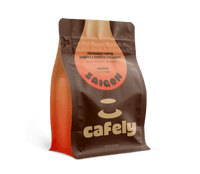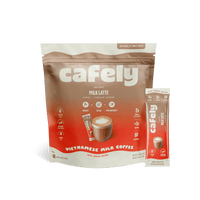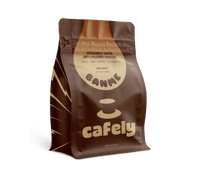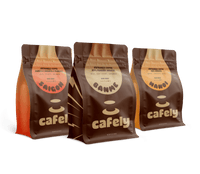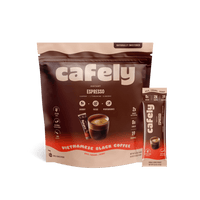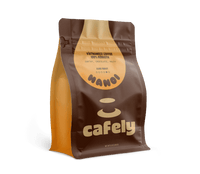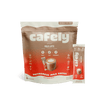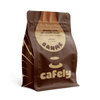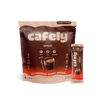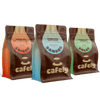Vietnamese coffee is renowned for being incredibly strong with a unique flavor.
This coffee is typically brewed using dark-roasted robusta coffee beans using a phin filter. The result is a highly concentrated, caffeinated drink with a bold, bitter flavor and an oily consistency.

The distinctive taste of Vietnamese coffee comes from the robusta bean which accounts for over 90% of coffee production in Vietnam and has put it on the map for being the second-largest coffee producer in the world by volume. Today, robusta makes up approximately 40% of global coffee production [1].
Coffeeshops in the West have scoffed at robusta for it’s stronger, bolder, and more earthy flavor compared to arabica coffee — but when prepared properly, this explosion of flavors is more of a feature than a bug.
Summary: Taste Profile of Vietnamese Coffee
- Earthy, nutty, and chocolatey notes.
- Perfect balance of bitter & sweet flavors.
- Many similarities in taste & texture to espresso coffee.
- Pronounce bitter edge.
- Rich, oily texture.
- Condensed milk provides intense sweet & creamy flavor.
- Unique flavor options are also available, such as coconut or ube.
What Sets Vietnamese Coffee Apart From Other Types?

Robusta coffee is often vilified as the inferior sibling of arabica, but it doesn’t deserve its negative reputation. Many people prefer the intense flavor profile to its milder counterpart, arabica.
While arabica is still considered to be the world’s favorite coffee, robusta is a much less fussy plant. It grows more quickly, producing a greater yield of coffee beans. It requires less maintenance than arabica and is therefore cheaper and more sustainable. It’s also packed with antioxidants and is lower in calories, sugar, and fat.
The robusta bean has been cultivated in many hot and humid climates, with its main areas of established growth in West Africa, Vietnam, and Indonesia. Coffea Canephora is produced in tropical areas at low altitudes of up to 600 meters above sea level. It can tolerate temperatures over 29°C and is resistant to disease, and pests due to its bitter taste. True to its name, it’s a fairly robust and resilient plant that thrives on minimal care, although it requires plenty of water to survive.
Related: History of Vietnamese Coffee
Distinct Taste
Robusta has an earthy flavor with hues of oak, dark chocolate, hazelnut, caramel, and a slight bitterness. While it is difficult to describe exactly what coffee tastes like, many have described it as woody and nutty. Unroasted robusta beans smell like peanuts, whereas roasted robusta smells like burned rubber. The characteristic rich, nutty taste is due to the beans being roasted in butter or oil. The strong, bitter taste is due to robusta having almost twice the caffeine content of arabica. Combining a strong espresso with sweetened condensed milk and ice is the authentic way to enjoy Vietnamese coffee.
Related: Why is Vietnamese Coffee So Strong?
Distinctly Higher Caffeine and Chlorogenic Acids
The high caffeine content and chlorogenic acids [3] present in robusta are the compounds that are responsible for its bitter profile and contribute to its color. When coffee is dark-roasted, the acids break down into individual components giving the coffee a more bitter taste and a dark brown color. This is why Vietnamese coffee has a higher caffeine content than other coffees.
Distinctive Aroma
Robusta coffee is often described as having a sweet, earthy aroma. During the roasting process, chemical and biological reactions occur in the coffee beans, which causes their components to break down and transform them into volatile compounds. The breakdown of different acids causes different smells, such as the caramelization of sugars to produce sweet notes or burnt, nutty smells. However, different people experience aromas in different ways. We will also perceive the smell of coffee grounds differently from the smell of the final cup of coffee once water is added. Indeed, we will get a different sensory experience at all stages of the coffee-making process depending on variables such as weather conditions, location of plants, ripeness, processing, and brewing choices.
Factors that Impact the Taste of Vietnamese Coffee

Robusta originated in the tropical areas of Africa. It’s difficult to know its exact origins because, unlike arabica, robusta requires cross-pollination from two species to produce cherries — and there are many variations, some of which remain unknown.
While farmers need to grow different types together for successful fertilization, they are not always fully aware of which types they are cultivating. Some plants are not even compatible with one another. The differences in robusta varieties and processing methods affect cup quality and taste.
Climate & Environment
The climate is imperative for successful maturation as is the quality of the soil in which the plants are grown. Temperature and rainfall affect the quality of the plant and a lack of moisture and sunlight could impact the process of photosynthesis. The ultimate taste of brewed coffee is dictated by how plants absorb nutrients from the soil and how nutrient-rich it is to begin with. Two coffee plants might have a similar genetic structure, but their environment can create subtle differences in their taste.
Picking & Fermentation
Picking and fermentation are also important stages of the coffee-making process. The cherries need to be picked at the correct time to eliminate the risk of under or overripe fruit, and drying time can affect the quality of the beans. The tools and practices used by different farmers to process the beans can also influence the level of sweetness or acidity of the final taste.
Roasting & Aging
The roasting and aging stage is also a delicate science in terms of the overall flavor of your coffee. The roast temperature, the amount of time the beans are roasted, and the length of cooling time all affect the flavor of your cup. The age of the beans before you grind them, as well as the size of the grind, can also affect the end result.
Brewing Method
Finally, the brewing method you choose affects the taste of your coffee. While inexperienced coffee drinkers might not notice the subtle differences between the drip method, pour-over, or plunger-style coffee brewer like the French press, experienced coffee connoisseurs will be able to pick up on differences in flavor, which indicate how they were prepared. Vietnamese coffee is traditionally made using a phin filter, which extracts more flavor from the beans.
There is not one single factor that creates robusta’s unique flavor, but a combination of all of the above elements that contribute to its distinctive flavor profile. Climate and location are a huge consideration for the plants to thrive, but many more steps must be taken to produce a consistent cup of coffee.
Advantages of Vietnamese Coffee

Inexpensive
As the freeze-drying process in instant coffee requires a lot of ground coffee to produce a small quantity of instant granules or powder, robusta is the ideal choice for mass-produced, supermarket instant coffee. Not only does the high caffeine content protect it from the extreme heat used in the coffee-making process, but it is also inexpensive to produce.
Related: Where to Buy Authentic Vietnamese Coffee?
Resilient
Climate change is threatening the survival of arabica plants because they are not resilient against pests, diseases, or rising temperatures. In contrast, robusta plants are much hardier against environmental issues, thriving under less than optimal conditions.
Greater Yield
Robusta plants produce high yields, with each plant producing far more coffee beans than arabica plants.
How to Make Your Vietnamese Coffee Taste Less Bitter
If you struggle with the bitter profile of robusta, there are certain techniques you can implement to reduce the bold flavor while still enjoying a traditional cup of Vietnamese coffee. The addition of cream or condensed milk is key to reducing the intensity of the taste, and there are dairy-free alternatives available, but what if you prefer a slightly less authentic cup of black coffee?
First, ensure you are purchasing high-quality coffee, such as HaNoi coffee, or opt for a blend, such as SaiGon OG coffee, which has a milder taste. You can also tweak the grind size or use a lower water-to-coffee ratio. Using a slightly cooler water temperature might also help, or changing your brewing method to cold brew for a shorter extraction time.
Some people argue that sprinkling a small amount of salt into your cup or adding a small amount of salt to the grounds before brewing can trick your taste buds into eliminating the bitter taste.
Related: What is a Phin Filter?
FAQs: Vietnamese Coffee

Still have questions? Check out our FAQ section to find out more about Vietnamese coffee.
1. How can I tell the difference between arabica and robusta coffee beans?
While there are very slight differences in size and shape, the easiest way to differentiate arabica and robusta is flavor. Arabica has a smooth floral taste with hues of berries and chocolate, whereas robusta has a slightly bitter profile with notes of smoked wood and peanuts.
2. Do I need to use a specific grind size for Vietnamese coffee?
We recommend using fine-ground coffee to make Vietnamese coffee. It should feel like sand when you rub it between your fingers. Learning how to grind your coffee beans properly helps you achieve the perfect texture and flavor for every brew.
3. How should I store Vietnamese coffee?
The best way to store coffee grounds is in an airtight container away from direct sunlight and moisture. Consume your coffee within a month to enjoy it at its best.
4. What is the ideal water temperature when brewing coffee?
Ensure your water temperature is between 195 and 205°F.
References
- Jarrod, K., Vivekananda, M. B., Shahbaz, M., Alessandro, C., & Mario, P. (2021). Temperature and rainfall impacts on robusta coffee bean characteristics. Climate Risk Management, 32, 100281.
- Preedy, V. R., Ed. (2015). Coffee in Health and Disease Prevention. Academic Press, 1033–1046
